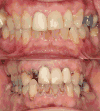Personalized periodontal treatment for the tobacco- and alcohol-using patient
- PMID: 30198132
- PMCID: PMC6132065
- DOI: 10.1111/prd.12229
Personalized periodontal treatment for the tobacco- and alcohol-using patient
Abstract
The use of various forms of tobacco is one of the most important preventable risk factors for the incidence and progression of periodontal disease. Tobacco use negatively affects treatment outcomes for both periodontal diseases and conditions, and for dental implants. Tobacco-cessation programs can mitigate these adverse dental treatment outcomes and may be the most effective component of a personalized periodontal treatment approach. In addition, heavy alcohol consumption may exacerbate the adverse effects of tobacco use. In this review, the microbiology, host/inflammatory responses and genetic characteristics of the tobacco-using patient are presented as a framework to aid the practitioner in developing personalized treatment strategies for these patients. These personalized approaches can be used for patients who use a variety of tobacco products, including cigarettes, cigars, pipes, smokeless tobacco products, e-cigarettes and other tobacco forms, as well as patients who consume large amounts of alcohol. In addition, principles for developing personalized tobacco-cessation programs, using both traditional and newer motivational and pharmacological approaches, are presented.
© 2018 John Wiley & Sons A/S. Published by John Wiley & Sons Ltd.
Conflict of interest statement
The authors report that they have no conflicts of interest related to this publication.
Figures



References
-
- Akamatsu H, Asada M, Komura J, Asada Y, Niwa Y. Effect of doxycycline on the generation of reactive oxygen species: a possible mechanism of action of acne therapy with doxycycline. Acta Derm Venereol. 1992;72:178–179. - PubMed
-
- Al-Ghamdi HS, Anil S. Serum antibody levels in smoker and non-smoker saudi subjects with chronic periodontitis. J Periodontol. 2007;78:1043–1050. - PubMed
-
- Albandar JM, Streckfus CF, Adesanya MR, Winn DM. Cigar, pipe, and cigarette smoking as risk factors for periodontal disease and tooth loss. J Periodontol. 2000;71:1874–1881. - PubMed
-
- Alguacil J, Silverman DT. Smokeless and other noncigarette tobacco use and pancreatic cancer: a case-control study based on direct interviews. Cancer Epidemiol Biomarkers Prev. 2004;13:55–58. - PubMed
Publication types
MeSH terms
Grants and funding
LinkOut - more resources
Full Text Sources
Other Literature Sources
Medical

